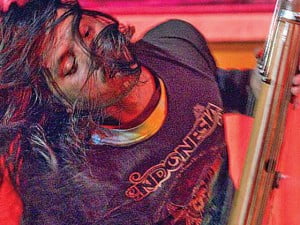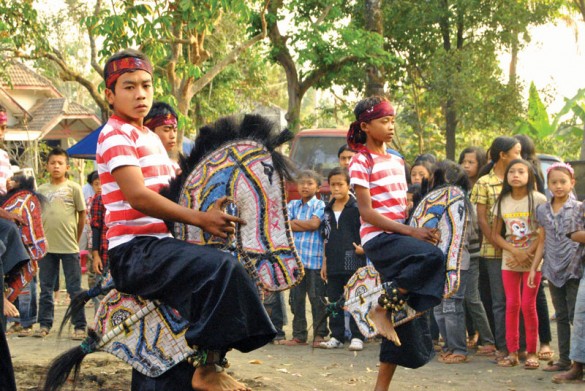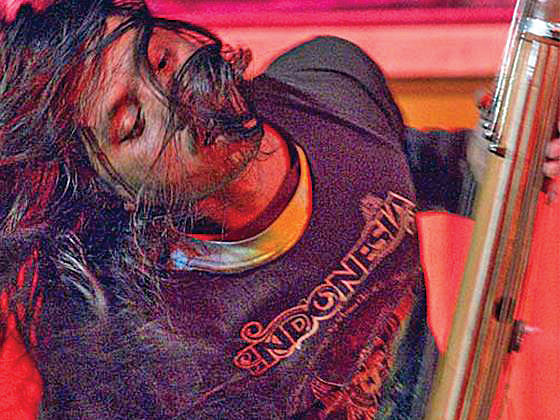
Wukir Suryadi is just back from a tour in Europe with his two-man band, Senyawa, and is now preparing for concerts in China, this September. But despite such international success, Senyawa has refused to lose their unique Indonesian style. Wukir Suryadi plays a one-metre long bamboo instrument (Bambu Wukir) with eleven strings attached (eight are made from the bamboo skin). He constructed it himself, along with the garu (meaning plough in Javanese), which he created from a disused farming device and he’s constantly seeking inspiration for new instruments from his surroundings.
I first saw them play in Malang, East Java, and was amazed by their ‘magical’ energy and the innovative spirit of Senyawa – I was in awe of their fearlessness on stage. In a recent interview with Wukir, I managed to delve into his past and discover some of Senyawa’s secrets.
It was the intense energy of the traditional Javanese dance Kuda Lumping that had a big impact on Wukir’s childhood – when he was eleven years old he joined a dance group in his village and those strong memories still influence him when he creates a musical piece today. Kuda lumping is a performance where dancers ride bamboo or rattan horses, often entering into a trance-like state, whilst others will perform and pretend to eat grass or neigh like a horse to work the crowd. As a spectator, I’ve sensed the energy in the atmosphere as it soaks into the audience and the trance-like state induced in some of the wide-eyed dancers by the repetitive sounds of the dog-dog drums and the gongs.
With this kind of background, it’s easy to imagine why Wukir seems to ooze with ‘magic’ on stage. But as he explains, “When playing on stage, the players themselves provide energy because the music itself is the energy (power).” Curious to learn more, I ask how they become so fearless on stage. “Because there’s an awareness of sharing everything with the audience – there’s also a trick to that…” Wukir laughs, unwilling to spill all of his secrets.
Yet Senyawa are still evolving and the duo recently learnt about stamina management during their two week tour of Australia with the band Regurgitator, “It was cool and crazy all at once, a precious lesson for us, you can imagine in two weeks – concerts in 12 different places, a lot of cities in Australia, every night a concert with a minimum of 25,000 watt sound system, with 3,000+ audience, sleeping, catching a flight, moving city, another sound-check, like that every day. So we strived to learn about stamina management, time discipline and totality”, said Wukir.
Senyawa’s music is loud and intense and I remember thinking how different their rhythms were to Western music. Their style is unmistakably Indonesian. No compromises. The vocalist, Rully Shabara, unleashes his sounds with phenomenal confidence and the jazzy, jingling sounds of the Bambu Wukir, with its hints of the “rhythm, melody and atmosphere” of Kroncong, entices the audience. Wukir embraces Rully’s vocal exploration of traditional styles and dancing chants and encourages him to deepen his knowledge of vocal techniques from where he was born. The pair has a near-parallel artistic vision and their first performance together was an adrenaline-pumping improvisation.
But they are just two creative fish floating in the polluted ocean of the music scene, which seems to favour blandness over talent. Reacting against this “crazy industry” and the Westernization of many Indonesian musicians, Wukir set about designing his own instrument in Bali where he discovered an abundance of bamboo. He is concerned about the industry’s preoccupation with quantity rather than quality, “I just try to keep on fighting, making art from the earth that we inhabit, with instruments inspired by the history of this nation.” Wukir, widely influenced by Indonesian rhythms, learnt to play the flute, bamboo flood, kecapi and the djembe drum before designing his own sounds. I ask him again why he constructed an instrument and he simply replies that it was a response to his surroundings. I smile – Wukir is really unaware of how liberated his mind is – he’s entirely free to create and if the instrument holds him back, he’ll make a new one.
Perhaps his interest in traditional music and dance such as Gandrung Banyuwangi and Reog shaped him. I first saw a Reog performance in Solo at a srawung (a Javanese gathering and sharing of knowledge) and saw the huge 30-40kg mask of the Singa Barong, a mythical lion, shaking across the grass field. At the event I met another unique artist – Misbach Bilok – who designs his own music installations from materials such as bamboo in combination with natural sounds such as dripping water hitting a gong. He spent two years exploring sounds for his ‘bamboo fish’ installation and was inspired by the fishing island of Selayar, Sulawesi, where he grew up.
It’s encouraging to know that some musicians are interested in traditional materials such as the hollow and sustainable bamboo. The suling (bamboo flute) is played across Java and Bali, usually in gamelan ensembles, and they have an ancient heritage – appearing on the 8th century bass reliefs of the Borobudur temple which also portrays an ensemble of bells, drums and a lute. Jegog (bamboo xylophones) were created for Balinese gamelan, and in the 1860s, in Minahasa, Sulawesi, ‘bamboo trumpets’ were developed as imitations of the European instruments, introduced by missionaries.
Now after hearing Wukir’s words, I’ve been thinking about instruments non-stop. As a child I played the electronic piano, but practicing always felt like a chore. Perhaps I hadn’t picked an instrument that allowed me to express myself the way that artists such as Wukir and Misbach are able to. But as Wukir says, it’s not just about the tools – the musician has to care about the audience, “A musical event could be considered a success if the audience can enjoy, sink and fuse with the music presented, until afterwards, they find it in their minds and their feelings; and the musician, whilst playing, gives the totality of his soul.”
Further information
Senyawa on Facebook: https://www.facebook.com/senyawaduo?hc_location=timeline
Film about Senyawa, Calling the New Gods: http://vimeo.com/54891015




